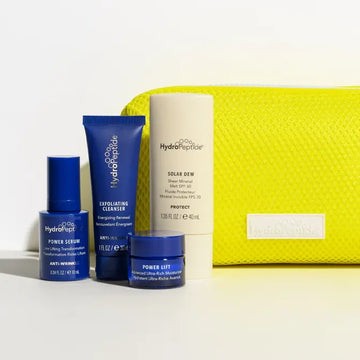
Peptides in Skincare: Myths vs. Facts
Share
They promise everything from wrinkle reduction to barrier repair, but how much of the hype around peptides is real? Dr Lauren Jamieson and HydroPeptide’s Ian Vitek separate science from skincare myth.
Myth 1: All peptides do the same thing
Not exactly. “Peptides are short strands of 2–100 amino acids which are essentially fragments of proteins that act as cell signallers, changing cellular behaviour by influencing gene expression,” explains HydroPeptide KOL, Dr Lauren Jamieson. “They stimulate pathways that treat the source of ageing and other problems in the skin, not just the symptoms.” I.e. peptides aren’t one ingredient but a whole family of actives that do different jobs.
Signal peptides tell cells to produce more collagen and elastin, carrier peptides deliver minerals such as copper and magnesium to aid repair, enzyme-inhibitor peptides help slow the breakdown of collagen and elastin, and neurotransmitter peptides can soften expression lines by reducing the micro-movements of our facial muscles that deepen them.
Myth 2: Peptides only target ageing
They’re brilliant for firming, and smoothing, yes, but they can do so much more. “Peptides in skincare can treat lines and wrinkles, skin laxity, pigmentation, acne, and sensitivity,” says Dr Lauren Jamieson. “Essentially, any process of concern in the skin is likely to be improved by using appropriate targeted peptides.” That versatility shows up beyond fine lines as peptides help strengthen the barrier by dialling down inflammation and oxidative stress, making them useful for reactive or post-procedure skin too.
They can also support acne-prone skin. “I love using the Hydropeptide Acne Warrior Collection, as it includes granactive ACNE, a clearing peptide that works synergistically with ingredients like salicylic acid to clear pores and kill acne-causing bacteria,” shares Jamieson.
Myth 3: You’ll see results overnight
If instant gratification is your thing, peptides will test your patience. Their magic is communication, not shock tactics. As HydroPeptide cosmetic chemist Ian Vitek notes, “peptides do not provide immediate results, instead, they gradually condition the skin into a new epigenetic state that maximises the production of key structural proteins.” Basically, they help skin remember how to behave like its younger self, but that takes time and consistency.
Myth 4: Peptides can’t penetrate the skin
Another common misunderstanding is that peptides only work on the surface of the skin. Actually, peptides are tiny, which means they can work beneath the surface where structural change happens. “Peptides are absorbed into the top layer of the skin and instruct the cells below to produce collagen and elastin, encouraging the skin to look and act younger,” says Dr Jamieson.
Myth 5: Peptides don’t mix well with other actives
They do, but they need to be tag teamed thoughtfully. “By themselves, peptides aren’t great for exfoliation, cleansing, antioxidant protection, or hydration,” says Vitek. “This is why pairing them with ingredients like AHAs, gentle surfactants, antioxidants such as vitamin C, and humectants like hyaluronic acid can maximise desired benefits.” However, strong acids can render peptides inactive.
So, if you love your glycolic or salicylic, use acids on alternate evenings and apply your peptide serum on non-acid nights. For daytime brightness plus firming, HydroPeptide LumaPro-C Serum, pairs stabilised vitamin C with supportive peptides for luminous results.
Myth 6: Peptides aren’t pregnancy-safe
“Generally, peptides themselves are considered safe for use in pregnancy,” says Dr Jamieson. “They can be very helpful to manage some of the changes seen in skin as a result of hormonal shifts, such as dryness, sensitivity, and pigmentation.”
Do check the full ingredient list before purchasing any skincare while pregnant as some peptide products also include actives like high-strength acids or retinoids that aren’t recommended in pregnancy or while breastfeeding.
Myth 7: More peptides equal better results
The saying less is more applies often when it comes to skincare regimes. Over-layering multiple peptide products can overwhelm skin and cause irritability. What matters is clinical concentration and smart companions. “Lots of brands contain peptides, but peptide percentage is key,” says Dr Jamieson.
Look for brands that are transparent about levels and designed to support signalling with barrier aids like ceramides, glycerin and antioxidants. HydroPeptide Power Serum, is a good example of a one and done youth-boosting peptide product, as it contains a concentrated peptide complex cushioned by hydrating and soothing actives for daily use.
Myth 8: You need clinic treatments to make peptides work
In-clinic procedures like microneedling can complement your routine, but homecare is where the long game is won. “Focus first on your main skin concern and use appropriate peptide-containing products that will target that concern,” advises Dr Jamieson. Vitek adds that consistent daily use is essential to condition the skin for the benefits you want.
A simple routine that works goes a little like this - cleanse, apply a peptide enhanced serum and/or cream that address your skin concerns, and top with SPF. At night, cleanse, and use a retinoid on alternate nights, and a peptide packed serum and/or cream on the others. moisturiser whenever your barrier asks for it.
Future-proof your skin with peptides
Peptides aren’t quick fixes, they’re quiet builders. By sending targeted signals to boost collagen, support elastin and calm inflammation, they help your skin hold on to collagen and elastin for longer and function at its best to hold off acne, hyperpigmentation, moisture loss and more.
The win comes from consistency, so choose a peptide serum or moisturiser that targets your main concern, use it daily, and let the results accrue.
